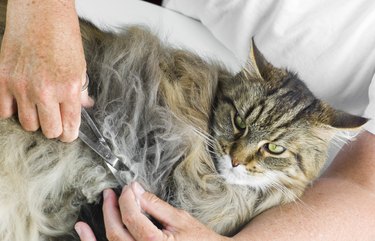If your cat's fur gets too tangled and matted to comb out, you can shave the fur with clippers to remove the mats. Never use scissors to cut mats, as the risk of cutting your cat's skin is too great. Matting can be very uncomfortable and may even lead to health conditions if the mats are not removed. Keep a close eye on your cat's coat, especially if you have a long-haired cat, and comb out mats before they become problematic.

Video of the Day
Should you shave your cat?
Removing mats from your cat's fur is important for your cat's appearance, comfort, and health. If you find a mat or tangle in your cat's fur, try to comb it out or detangle it with your fingers. Loose mats can usually be removed this way, but as the matting gets worse, trying to comb out the mat is ineffective and painful for your cat.
Video of the Day
If mats can't be combed out, it is best to shave them. If you have professional pet clippers, you can clip your cat at home. Shaving can be quite stressful, and few cats will stay still for the procedure. Make sure you have someone to help you hold your cat while you shave her.
While you are less likely to injure your cat when you use clippers instead of scissors, it is still possible to cut your cat's skin. If your cat isn't cooperating or if the matting is severe, it is best to take her to a professional groomer or your veterinarian since they are trained, and there is less risk of injury during clipping.
How to remove mats
Use a #10 blade on your clippers and make sure the blades are clean and sharp before beginning. Use the clippers to remove the mats. Make sure that the cat's skin is smooth and flat. Keep the clipper blade flat against your cat's skin. Don't angle the blades, as this can increase the risk of cutting his delicate skin.
Move slowly as you remove the fur and make sure your cat is calm and still. Check the blades frequently to make sure they aren't overheating, which can burn your cat's skin. If you do nick or cut your cat's skin, be sure to take him to a veterinarian. Even small cuts can get larger since the skin stretches when your cat moves and jumps. In addition, the wounds are at risk of infection.

After removing the mats, you will have a clear view of the skin underneath. While some redness, bruising, and irritation are normal from the matted fur, make sure you get treatment if you see wounds or pests, such as fleas.
Prevent future mats
Matting is most common in long-haired cats and usually occurs when the dead hair in the undercoat gets trapped and tangles in the topcoat. Matting is also an issue if your cat's hair is especially dirty and is more common in areas that are more difficult for your cat to reach, such as under her chest or collar. While many cats groom themselves sufficiently to prevent issues, some cats may have problems if they are overweight or have an injury or arthritis that limits movement.

Brush your cat regularly to remove tangles before they have a chance to turn into mats. If your cat doesn't allow you to brush her, consider regular trips to the groomer to prevent more serious matting down the road.